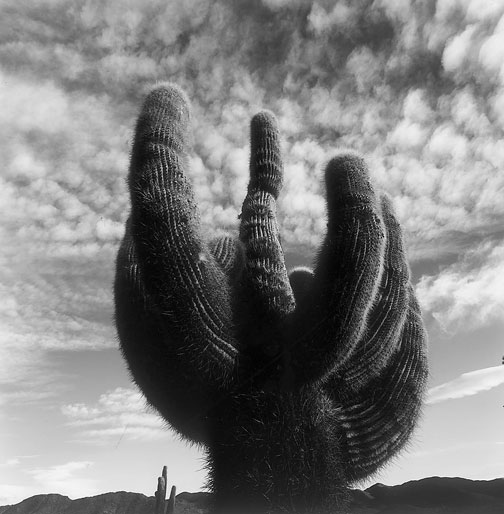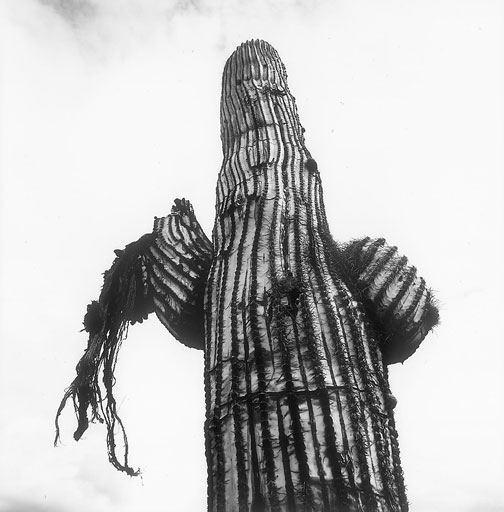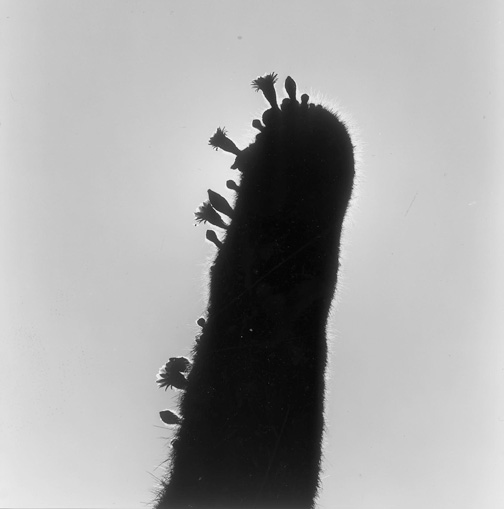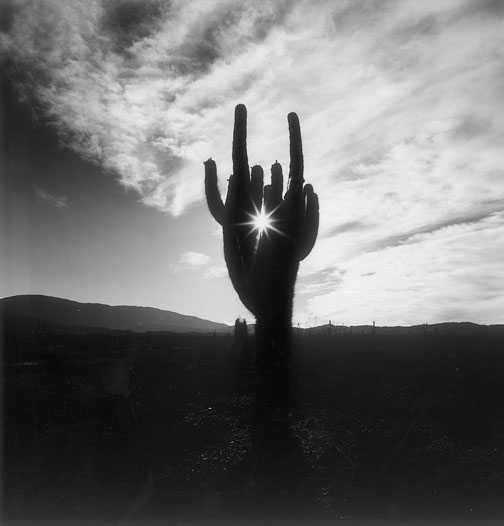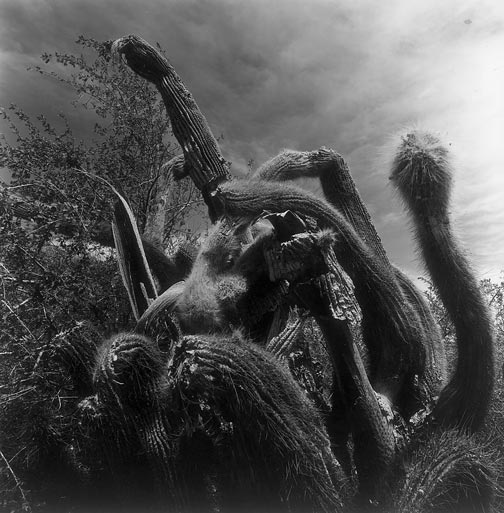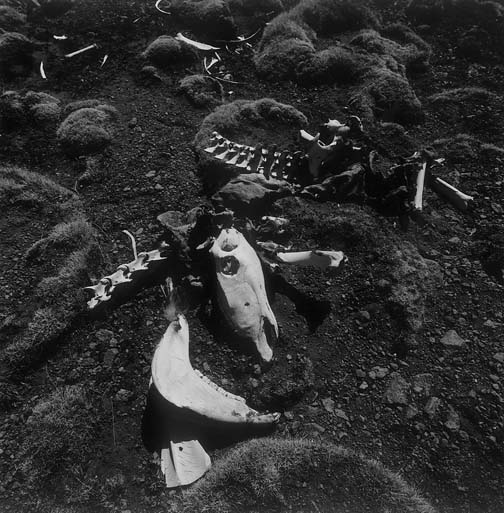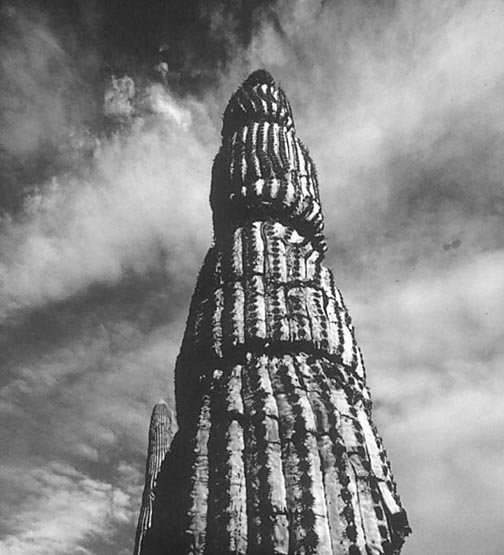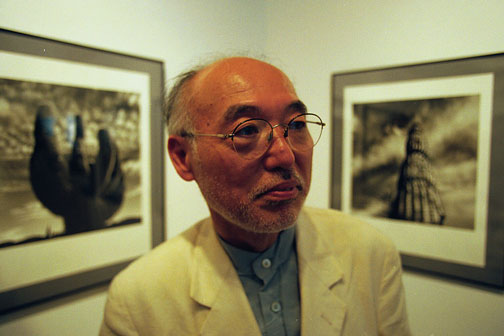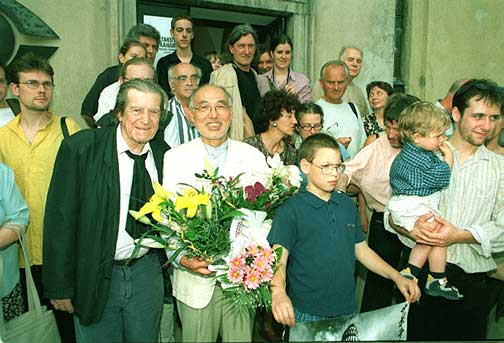Mala Gallery ZPAF-CSW
8, Zamkowy Sq., Warsaw
June 6-30, 2000

Takuya Tsukahara "Cactus Fantasy" - exhibition in Mala Gallery in Warsaw, June 2000
HE SMALL, blue star of Earth is inhabited by countless forms of priceless life. Essential for their existence are sunlight, water and a thin protective layer of atmosphere. What would happen to this terrestial forms of life if any of these elements will change?
The environment in which life is developing is being eroded by unrestrained development of human civilisation. It is hard to estimate how great is the man's fault. The gift of life so rare in the universe has to be turned over to the future generations. But the irresistible marching of the human civilisation towards the future has already begun. And this scares me.
After presenting in 1990 the photographic series called "The Ocean Phantasy" I have taken up the subject of the Polish icons representing the Virgin Mary - "The Mary's Phantasy". The album with photographs of this series called "A pilgrimage to the 101 Polish images of the Madonna" has been published in 1999. At the same time I have decided to photograph giant cacti growing in the Andes: the result of this being "The Cactus Phantasy". All these "phantasies" although so different have a common denominator. They do express my anxiety as to the future of the man and the Earth.
When I saw these giant cacti in the Andes for the first time I was bewitched by their tremendous vitality. And when I saw in the upland desert a dead cactus which ended its life in such exteremely difficult conditions, I was enchanted by beauty of natural death, which was not caused by an external factors.
But in the year 1998, when I have finished taking photographs, I was astonished by the changes in these cacti. During two years many of the cacti have weakened, have lost their skin and thorns and the branches - their arms drooped like if the heavens towards which they reached out their hands sent the evil power jeopardizing their future. We are not allowed to turn this exceptional gift of life into dead emptiness.
Takuya Tsukahara "Cactus Fantasy" - exhibition in Mala Gallery in Warsaw, June 2000
Takuya Tsukahara "Cactus Fantasy" - exhibition in Mala Gallery in Warsaw, June 2000
Takuya Tsukahara "Cactus Fantasy" - exhibition in Mala Gallery in Warsaw, June 2000
Takuya Tsukahara "Cactus Fantasy" - exhibition in Mala Gallery in Warsaw, June 2000
Takuya Tsukahara "Cactus Fantasy" - exhibition in Mala Gallery in Warsaw, June 2000
Ever since when I was nursing a cactus in my boyhood I was interested in independent nature of cacti, the fact that have totally distinct character from another plants and that there is such diversity of their species. In my school times I saw the Walt Disney's movie called "A living desert". I can still emember silhouettes of big cacti reminding humans. I saw them as a symbol of future life forms on the Earth. I have decided to realise "The Cactus Phantasy" after "The Ocean Phantasy". The inspiration for this work was the book of Yu Ryutanji so entitled. In this book I have found an information that such cacti grow in the Andes. Thanks to my contacts with Argentinian museum workers and artists I was able to make my journey to Argentina. /.../
The giant cacti of the Tintina Desert lasted for decades and centuries in spite of storms, winter rains and snows, deadly sun or lack of oxygen in rarefied mountain air.There are a few places so hostile to life as the Andes. But the cacti nevertheles do last - having no hope to multiply like the other plants - not seduced by rivers and fertile soil of lowlands. Why they do not try to descend from these 3500 metres?
For me the most moving is this world on the borderline between life and death and the cacti that live there in place so distant from the world endangered by civilisation. Once ago under blue skies of the 6000 metres high Andes lived the Incas for whom a thimbleful of water and scarce in oxygen air was sufficient. The Incas are extinct now and even condors belong to endangered species. They are the victims of the greedy human civilisation.
I also have been raised in a society which has created and propagated such a civilisation. Everyday I am surrounded by a sea of media informations - what it is good for? The most advanced knowledge and science crates the weapons of mass destruction. The people from so called developed countries watch everything through their TV sets, but they cannot afford to act. And missiles coming from the world's other end put in danger the people from poor countries who have no means to defend themselves.
The people from economic powers are watching wars and destruction on their TV screens like it would be a virtual reality.
The great monuments of civilisation are like tower of Babel that fears no God. Somewhere in the darkness of space, beyond the reach of our sight there are worn out, dead satelites. Thanks to technical progress we are able to watch the beauty of the Earth from the space. But is it possible to see from the space these innumerable forms of life? Is it possible to see how this life is suffering and dying in the shadow of civilisation?
I went to Argentina in 1992 and then in 1994 and 1996. The Tintina Desert, the craddle of the giant cacti that once seemed to me to be a gate to the universe once again was blooming with its vitality. Some of cacti, which grow only 10 centimetres a year, were 6 meters high. All of them were growing, full of juvenile energy. The cactus "Victoria" so named by me because of its arms making letter V seemed to be still young. But I have seen also mumified remnants of an old cactus which ended its life with dignity. It was beautiful, natural death.
I saw alarming changes when I went there again in 1998. My Victoria cactus or another familiar shapes were not there anymore. Those that survived were changed - miserable, with skin and thorns peeling off. Nevertheless once ago I have been seeing in them the hope for the Earth's future life. Something has had to happen if over there, on the world's other end so much changed. Perhaps it was the human conceit that brought about danger to this eternal craddle of cacti in the Andes.
Takuya Tsukahara
Takuya Tsukahara "Cactus Fantasy" - exhibition in Mala Gallery in Warsaw, June 2000
Takuya Tsukahara in Mala Gallery. Photo: Jerzy Gumowski/GW
Takuya Tsukahara has graduated from the Depatment of Photography of the Nihon University. He exhibits his works since 1967. He was awarded in 1975 with the prize of Photographic Society of Japan for his 1973 exhibition "Touching the space, white game". In the same year, thanks to the grant from the National Cultural Agency, he went to Poland. For the first time this distinction was awarded to a photographer - artist. This journey marked the begining of his strong artistic ties with Poland. Takuya Tsukahara is honorary member of the Union of Polish Art Photographers. His most recent book entitled "101 Madonnas" documents the most famous Polish icons depicting the Virgin Mary.
See also:
Takuya Tsukahara with his guests in front of Mala Gallery in Warsaw on June 6th, 2000. Next to Tsukahara is his long-time friend, painter Gaber Rechowicz. Photo by K. Wojciechowski.
Copyright © 1997-2012 Marek Grygiel / Copyright for www edition © 1997-2012 Zeta-Media Inc.
e-mail: fti@zeta-media.com
